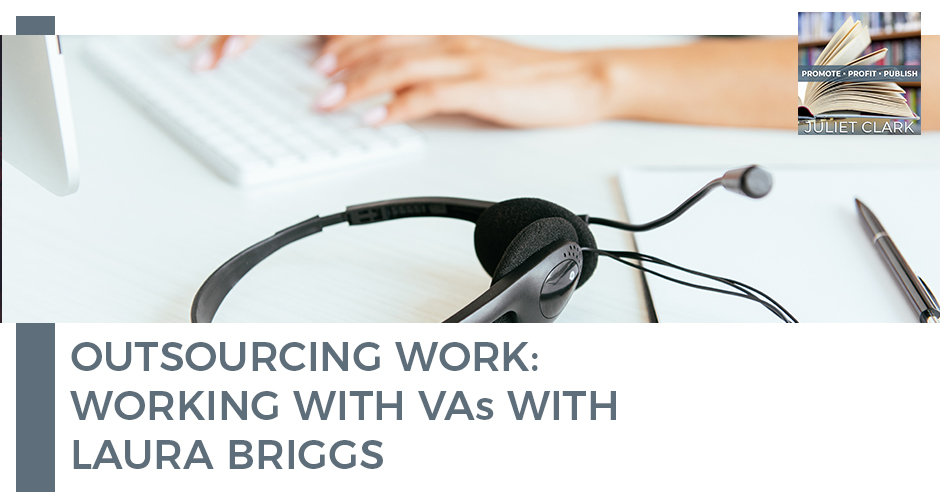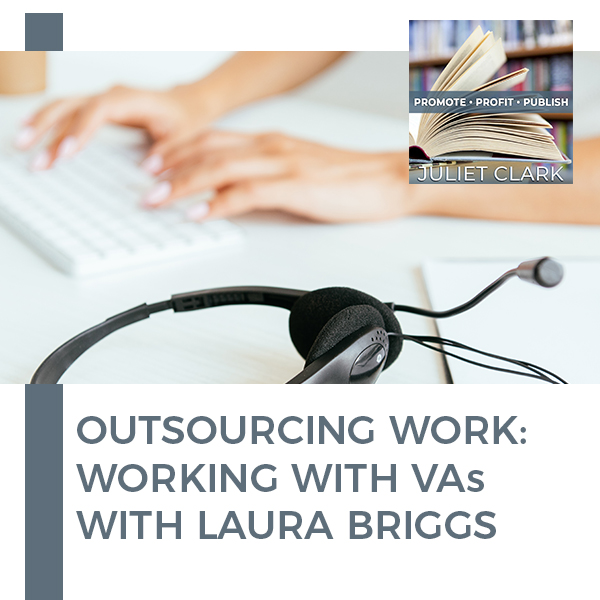
There is a point on your path to growing your business where the number of tasks and responsibilities becomes impossible—irresponsible, even—to handle alone. That is the point when you must begin to delegate, and the first step is outsourcing work to people you can trust. Laura Briggs is a former teacher turned entrepreneur and freelance writer, and is also the author of Start Your Own Freelance Writing Business. Laura discusses the ins and outs of working with VAs to make sure your business continues to function, from the most important aspects of hiring to the day-to-day processes, with Juliet Clark. If you’re looking to start outsourcing work, this is definitely a great place to start familiarizing yourself with the processes.
—
Watch the episode here
Listen to the podcast here
Outsourcing Work: Working With VAs With Laura Briggs
Our guest is Laura Pennington Briggs. We’re going to talk about hiring VAs, outsourcing, what to outsource and being a freelancer too. Laura has such an interesting story because, like two of my former VAs, she is a military wife. For those of you who don’t know, it’s hard for military wives to go to a new town and start a job because their husbands move a lot. If you’re a male military spouse, your wife gets transferred a lot. I know in the course of my last VA that I had that was military, we were together three years and I think they moved 4 or 5 times. Her husband kept getting promoted. Laura is a former school teacher turned entrepreneur, freelance writer and author. Her first book, Start Your Own Freelance Writing Business, won the 2019 Author Academy Award’s Best in Business prize. She’s a two-time TEDx speaker and now coaches advanced freelancers on how to scale their businesses to six-figure level. Welcome, Laura.
I’m thrilled to be here.
Thank you. A lot of my people try to use VAs and they don’t know what they’re getting. How much is reasonable? Should they have more than one? I shared with you my story about my first real VA. She was $80 an hour and was doing things that should have been $20 an hour. How do you balance and manage all of that?
No matter who you hire, they should be doing the majority of their tasks within an hourly range amount that you feel comfortable with. If there are only maybe 1 or 2 things they do in your package that are worth $80 an hour, that might not be the right VA fit if most of what they’re doing is more down in the $25 or $30 an hour range. There are different types of VAs. Your beginner VAs and your more general VAs will charge a lower hourly rate. Your more experienced people, your online business managers, somebody who knows Infusionsoft or Ontraport the back of their hand, they will charge more in the higher hourly ranges because they have those skillsets. Leverage the person for the skillsets they have within that hourly range amount. You don’t want to be paying too much for somebody who’s doing simple tasks like data entry or some research that you could outsource as effectively for less.
That is such great advice because I paid my Infusionsoft VA when I had an Infusionsoft. I’ve changed now, but I think she was $57 an hour and she was cheap for Infusionsoft. I also have a VA that posts social media that’s $25 an hour. She does not create that. I want to stress that to you. That’s not somebody who creates it. I do my own content calendar and I tell her what to post. It’s good ranges for what we’re getting here.
Leverage the person for the skill sets they have within that hourly range amount. Share on XI would completely agree with that. When you make your list of what you’re thinking about outsourcing, you don’t want to dump it all on one person. You have a great model. A lot of people make the mistake of mapping out this big list of 15 or 20 tasks they want to be done. They go looking for this one magical person they think can do it all. It is far more effective to say, “I’ve got maybe 2 or 3 different types of tasks here. Maybe this group of tasks isn’t urgent, so I’m going to table it for now.” These two groups might be two different people. I’m not trying to force someone who’s good at Infusionsoft to try to learn or manage social media, which is something that you could probably outsource for less money. It’s smart to sort your tasks into different categories. When I hired one VA, she was a content manager. It was her job to publish blogs, videos and podcasts. They were a little bit different but all in that same general category. I felt confident that her hourly rate was in accordance with the type of tasks that I was outsourcing to her.
There are some agencies out there where you can go and get that one size fits all, which I did have for a while. Remember that the owner of the agency is going to mark up that work as well. It depends on what you want. If you want that person to manage for you, it might be worth it to you. If you feel like you can manage, then go for that person that’s a little bit less and that’s not going to be marked up. That would be a good way to go to. You work with people who want to be freelancers. Let’s address that first. What are some things that people need to know if they want to go out and do freelance writing or they want to be a VA? What do they need to know about getting their own business?
First of all, don’t believe the Facebook ad hype. We all see those people who have a picture of themselves with the laptop or somebody in a stock photo on a beach drinking a Mai Tai and claiming that they make six-figures as a freelancer. I know nobody who’s like that. Everybody puts on some level of work. Can you get paid well for what you do? Do you have flexibility in your schedule? Can you live almost anywhere? All of those things are true, but expect to work, especially when you first start because no one is going to bring you clients. You have to create all of your own opportunities. It’s also a good fit for people who are deadline-driven, great communicators and also great salespeople. Being a freelancer is selling you and your services all day long. I met a freelancer a couple of months ago and he was like, “I don’t have any clients.” We talked through his strategy and I said, “You’re doing no pitching.” He was like, “I hate sales.” I was like, “This is not the business for you to be in it. If you feel super awkward on every sales call, you’re going to struggle.”
We’ve all read The 4-Hour Workweek by Tim Ferriss and I know many entrepreneurs and you’ll totally resonate with this. They will come to me and what my services and say, “Here’s what I want. I want the cash machine.” I’m here to tell you the cash machine is a myth. You will find it when you find the Loch Ness monster floating around and in a little buoy around its neck. All of us work in this industry.
Why wouldn’t everyone be doing it if it were that simple? Every single person would quit their day job and create a cash machine if they could.

Start Your Own Freelance Writing Business: The Complete Guide To Starting And Scaling From Scratch
There are some benefits like I do get to work from home. My commute is about fifteen feet from my bedroom to my office in the morning. I can work anywhere in the country as can VAs, but you also miss the connection to people.
That is something to be prepared for. Isolation is a real challenge. I am an introvert and I like working alone, but even for me, sometimes it gets to be too much. If you’re the type of person who loves those water cooler chats at the office, you might want to consider working from a coworking space at least a couple of days a week or going to the coffee shop a couple of mornings a week. I also plan activities that are outside of my house that involve groups of people, whether it’s an exercise class or a painting class or whatever so that you’re getting out and about and speaking to other humans that are not in the entrepreneur world. It’s a good tactic to have because we’re good at talking our language, but it’s important to be around other people too and relate to them.
I have this thing in my talks where I talk about your first day of being your own boss. It’s amazing, you show up to your desk, you’re dressed up and you’re excited. By month four, you get how stressful it is. You’re sitting there unwashed and in your PJ. The dog is looking at you like, “Shower, get a life.” These people don’t realize how much work it is to wear all the hats in the company.
It is because you’re CEO, CFO, CTO, VP of Marketing. You are every department as one person. Some parts of that you might like at first. You might be like, “There’s variety in this. It’s awesome.” Once your business starts to grow and your ability to have your time shifts into working on client projects, then you go, “I can’t wear all these hats.” That’s where you need to start thinking about outsourcing at least some of these tasks to another person because otherwise, you get stuck on the hamster wheel of working in the business rather than working on it and growing it.
When you’re doing this, tell me if you agree on this, you need to outsource those things that you don’t like to do, things that you avoid and work right in your zone of genius.
The things you’re not good at. I will be upfront and say I am terrible at graphic design. No one wants to see anything I’ve made in Canva. My graphic designer has asked me to delete stuff that I tried to make in there. She said, “I go in and it offends me.” I’m like, “Delete it.” If you’re not good at it, it probably takes you ten times longer. If you don’t like doing it, you’re going to procrastinate on it. Those are the perfect tasks if they are business necessary. Social media might be another example. That drains me. I don’t want to do it. I could do part of the process and like you’re doing, passing it off to a VA. That’s a great approach to take with it because the more time you can spend in your zone of genius or recharging and thinking the big picture, the better your business is going to be for it. If you charge $200, $500, $1,000 an hour, don’t be doing those $20 an hour tasks.
That is true and complete transparency here from a neuromarketing standpoint, I can tell when you’re not good at Canva. It’s out of proportion, the colors are wrong and it looks weird. Hire a professional to do that for you because it is bad. How do you hire these people? How do you know who the right person is? There are a lot of different places to hire them too.
It comes down to three core elements. You want to have a great job description. You want to interview your candidates. Even if this is someone who is only going to work five hours a week, you still want to have at least a ten-minute conversation. You want to kick things off with a paid trial period or a test job. When you have a well-written job description, people will come in on it. They will also know exactly what their responsibilities are. I hired an executive assistant and all five of the people I interviewed were like, “Thank you for writing a job description that broke down percentages of time that you expected to spend on various tasks.” Each section had software you have to know or be willing to learn right away. The more time you put into the job description, the easier it is to attract the right candidates and the people who are in the wrong fit will go, “I don’t fit any of these requirements so I’m not even going to submit my application.”
When you make your list of what you're thinking about outsourcing, don't dump it all on one person. Share on XOnce you get multiple different applications, I’ve gotten anywhere from 20 to over 100 applications for VA positions, I use Google forms to capture their information so I can put it into a spreadsheet and I will do a quick scan. Anybody who’s way too expensive, way too cheap and doesn’t have the right experience, I will color that line red and then delete it. I’m looking for my greens, which are the standout people and then yellow, which is if I don’t have enough great people, these are the people I might consider beyond that. That’s who I interview. You want to have a video interview. If they cannot figure out how to download Zoom and get on with you for a ten-minute interview, this is a bad sign. You want to hear how they talk, whether you two gel. Do they understand the types of words you’re saying and the questions that you’re asking? Are they like, “I’ve never heard of Canva before and I downloaded Zoom for the first time?” If the job is tech-heavy, those are the things you want to be aware of.
You want to take a micro portion of something you want them to do when you hire them and give that as a paid test job. Ideally, you want to do that with 1 to 2 candidates so that you can compare. We’re not just testing for ability but we’re also testing for communication. You want to set a deadline, even if it’s arbitrary to you. Put a clear deadline on there like, “This is due in 72 hours,” because we want to see who’s going to wait until the last second to turn it in. Who’s going to wait until the next morning to ask you the questions they should have asked on day one. That’s how the cream rises to the top. A lot of people get surprised. Sometimes your best candidate on paper totally bombs the interview or the test job. That’s why it’s always good to have someone else in the background.
The last time we talked, I had given a test to someone and this is why you do it. I was doing 24 hours and 24 hours in, she hadn’t even gotten into the program. There’s a signature thing where I can tell when and what time you’ve been in. She came back and asked for more time and 24 hours more, she still hadn’t gotten into the program and I let her go. Here’s another thing that happened with the same project. I’m going to give you another caution. When you ask someone, “Can we do the project this way?” they’re supposed to know the software and they say yes, then they come back two hours later and say, “We need to make this and this change and we can’t do it the way I told you.” These are such red flags. This one project, I’ve had such a hard time with because people are winging it. Those are such good reasons to do this.
Do the test job and ask them that. Maybe you went through the interview process and you’re thinking about running them on for the test job, do a screen share and say, “This is what I’m thinking. Can you confirm that this is 100% something we can do?” The right person will either say, “Yes and I know that because of X, Y and Z. I did this project for someone else. I had to customize this for myself,” or they will be upfront, and this is my favorite VA quality when they tell me that I’m wrong. They are like, “You can’t do that. There’s a workaround.” They are showing their technical expertise there and saying why what I’m asking for is ridiculous and brainstorming potential solutions around that. Be wary of the yes-man or yes-woman.
What are some of the other red flags when you’re looking? One of the things that I can think of is people go overseas. They want to work with people in the Philippines. This has been my experience. I don’t want somebody to work overnight because if they have questions, I’m asleep.

Outsourcing Work: No matter who you hire, they should be doing the majority of their tasks within an hourly range amount that you feel comfortable with.
There are some challenges to outsourcing overseas. There are great people who work overseas and in different time zones. One of my online business managers in the middle of our relationship moved from Canada to Australia. We made it work for six months, but ultimately it was a problem. We needed to have regular conversations and it was too weird for all the work to be completed while I was asleep, and then I had to wait for another full workday to hear back on any of the questions. That’s something to keep in mind.
You want to be mindful of cultural or language barriers as well. A lot of people don’t know that when you hire someone in the Philippines, they expect to receive something called the 13th month, which is an entire month of pay after December. It’s like a Christmas bonus, but it’s a cultural thing and they expect it. If you don’t provide that, it’s awkward because they think then that they haven’t performed well. You want to be aware of, “If I’m working with someone in a different country, are there cultural things I need to know about? Are there work hours that I can expect?”
In general, if a person is doing what I would consider lower-level tasks, research, data entry, populating different fields and things like that, overseas is fine. If they’re client-facing, if they’re writing, if they’re doing some of these higher-level tasks, it’s hard to find someone who you can communicate with easily. In that case, you tend to get what you pay for. That goes back to categorizing those tasks. Who is the person I’m looking for? If 80% of what I need them to do is high-level tasks, I’m going to have to bite the bullet and pay somebody in the United States or Canada or somewhere else like that a little bit higher rate, but the quality and the time saved from me not having to refix things and revisit stuff is going to come out as a wash in the end.
Another thing I’ve run into is people who don’t pay for the meetings. You have to pay these people if you’ve had them show up. I was growing a company out in Florida. Five days a week, there was a meeting at 8:00 AM Eastern time. They didn’t want to pay these guys to be at that meeting, but they required them to. Remember when you do that, that’s their time. They’re exchanging time for money.
You should discuss that with your VA upfront too. There’s always the possibility if you put them on retainer, they might tell you, “You purchased at my gold level package so you get one free 90-minute call per month. We can break it into three 30-minute calls, but outside of that, you should expect to pay.” Another red flag to be aware of, this is one for me personally, I always ask my VAs what their vision for their business is. The reason I’m asking that is it’s amazing how many times I’ll even say in my job description, “I’m not looking for someone who has ten other clients,” because I know that my projects will be overlooked, done sloppy or turned in late when they have a million other projects going on.
Sometimes your best candidate on paper totally bombs the interview or the test job. Share on XI had this EA job I interviewed for. I asked that question and one person was like, “It’s my goal to be an entrepreneur and scale my business up to have 6 to 10 clients. I was like, “I appreciate this information because you are not the right fit for what I’m hiring right now.” That’s something to ask. If you’re hiring someone on more of an employee basis, you want to clarify that, “This has the potential to go to half-time or full-time. I want to know what else is on your plate. Do you have time for this or no?”
That’s great because I shared a VA with someone who had the VA on retainer. You’d be shocked how many times I’d say, “Where is this?” She’d say, “Something came up for,” and I’m not going to say her name. I’d be like, “I pay you too.”
Nobody wants to feel like that. I had a business manager that did that to me once. I constantly felt like every other client was more important than me and that I was bugging her to ask for things that should have been done. You want to be aware of that. A lot of new freelancers don’t know what their limit is. They’ll say yes to every client and you might end up getting burned in that process. Ask about that. Where are they now? Where are they hoping that their business goes?
That’s great advice. What else should they know?
It’s important to clarify your communication preferences. This is another question I ask on my Google form. How do you best receive instruction? I am terrible at creating written instructions. I don’t want to work with a VA who needs that because I’m not going to be able to give them what they need. Is it video, audio or written instructions? Is it me doing it with you, then we’re going to record that and you’re going to pass it off from there? Ask those questions so that from day one, the VA is clear about the best way to communicate with you. That’s another one I always tell mine, “Please don’t email me. I do not need any more emails. Please keep it in the project management tool.” You want to know that and discuss that with your VA upfront because they need to know, “How am I supposed to ask a question? What do I do if I have something urgent like I’m locked out of a software program and need a password reset?” You want to clarify those expectations upfront so they know when it is and isn’t okay to interrupt you.

Outsourcing Work: A lot of new freelancers don’t know what their limit is. They’ll say yes to every client, and you might end up getting burned in that process.
If you’re good at this, make training videos so that they can have a library of, “You go here to do this.” That was one of the things with the company that I was assisting and growing. They refused to make those videos and we had a steady stream of VAs in and out. It was frustrating for the person leading them to have to explain every single time. That’s always helpful too if you have repetitive tasks or things like that. This has been a lot of great information. Where can we find you? You have a free giveaway.
I have a PDF that’s The 24 Top Most Profitable Freelance Side Hustles. It’s also a great place to look if you’re thinking about outsourcing and wondering, “If I don’t use a general VA, who could I hire in my business as a freelancer that would save me some time?” It’s got information about what they do, the software they should know, and the average hourly rates for that type of freelancer. You can get that at BetterBizAcademy.com/sidehustle.
Thank you for doing this.
It’s my pleasure. It was fun.
Important Links
About Laura Briggs
 Laura Briggs is a former teacher turned entrepreneur, freelance writer, and author. Her rst book, How to Start Your Own Freelance Writing Business, won the 2019 Author Academy Awards “Best in Business” prize. She’s a two-time TEDx speaker and now coaches advanced freelancers how to scale their business to the six figure level.
Laura Briggs is a former teacher turned entrepreneur, freelance writer, and author. Her rst book, How to Start Your Own Freelance Writing Business, won the 2019 Author Academy Awards “Best in Business” prize. She’s a two-time TEDx speaker and now coaches advanced freelancers how to scale their business to the six figure level.
Love the show? Subscribe, rate, review, and share!









Leave A Comment